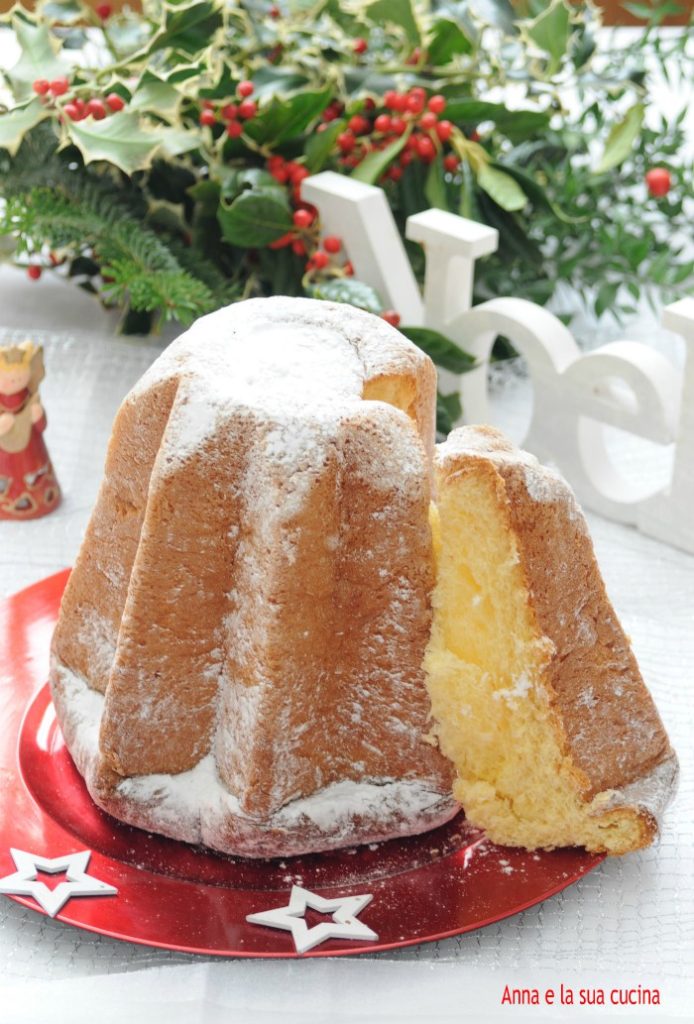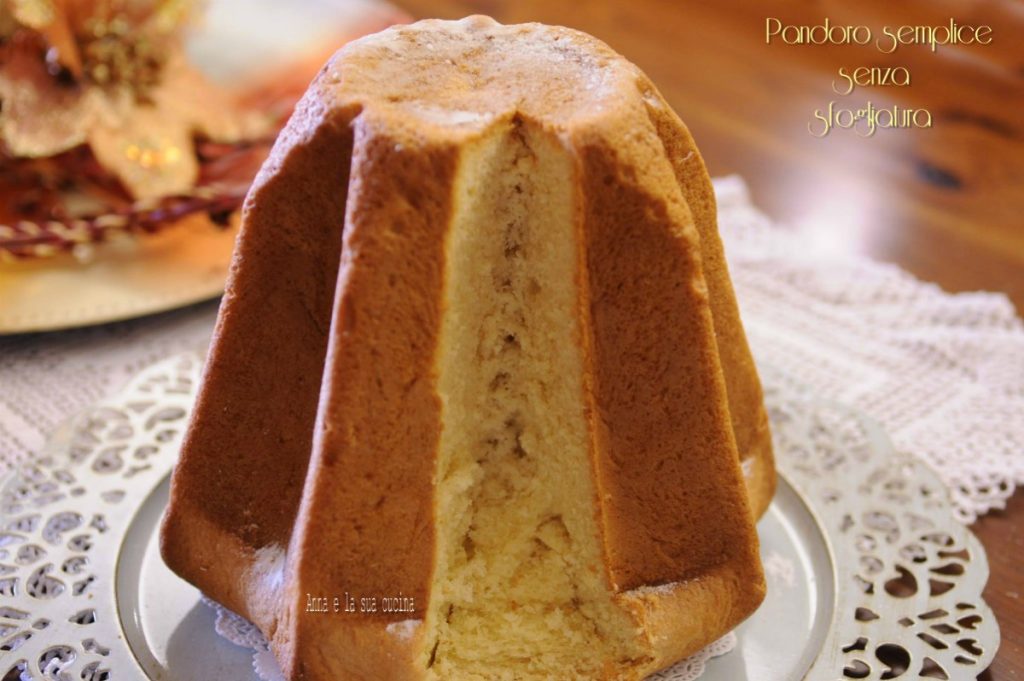The simple Pandoro recipe without layering is a typical leavened Christmas dessert, a great soft and fragrant cake, using a special tall star-shaped mold with eight points for baking.
This year I equipped myself with this mold too, and here I am with the first Christmas trials.
The process is a bit long due to the three doughs to follow, but it is not difficult to make, and then it is a great satisfaction to see it, taste it, and say “I made this”!
To enrich the Christmas table, for the joy of children, or to welcome guests, you cannot miss this delicious traditional Pandoro, both to taste and to give as a gift.
I got the recipe from a friend who prepares it every year with great results.
YOU MAY ALSO BE INTERESTED IN THESE RECIPES

- Difficulty: Medium
- Cost: Cheap
- Rest time: 1 Day
- Preparation time: 1 Hour
- Portions: 2.2 lbs of Pandoro
- Cooking methods: Oven
- Cuisine: Italian
- Seasonality: Christmas
Ingredients for the Pandoro without Layering
- 2 1/4 cups Manitoba Flour
- 2 tbsp Water
- 1/2 oz Fresh Brewer's Yeast
- Leavened Biga
- 3/4 cups Manitoba Flour
- 2 1/2 tbsp Sugar
- 2 oz Eggs (2 small eggs)
- First Dough
- 2 cups Manitoba Flour
- 2/3 cups Sugar
- 1 tbsp Wildflower Honey
- 6 1/2 oz Butter (soft)
- 5 2/3 oz Whole Eggs (about 3 medium eggs)
- 1 oz Egg Yolks (about 2 yolks)
- q.b. Vanilla Flavor
- 1 Lemon or Orange Zest (grated)
- q.b. Powdered Sugar
Tools
- 1 Stand Mixer
- 1 Mold
- 1 Oven
Pandoro Preparation
For the preparation of the biga:
To prepare homemade pandoro, start with the biga (the pre-dough).
Dissolve the yeast in warm water, add a bit of flour, stir with a spatula, when the flour is absorbed, pour onto a surface, knead the dough, gradually adding the rest of the flour, until forming a smooth ball. Place the ball inside a bowl, cover it well and let it rise until doubled, about 60/90 minutes, depending on the internal temperature.Preparation of the first dough:
Take the stand mixer, pour in the leavened biga, flour, sugar, and half of the eggs, set it to speed 3 and start working the dough, gradually adding the rest of the eggs. Continue working for about 10/15 minutes, during which detach the bowl from the mixer and gather the dough well at the bottom, then continue working until the dough detaches from the sides to obtain a smooth and elastic dough.
Form a ball and let it rise in a draught-free container, well covered to avoid crusting. Let rise until doubled in volume (60-90 minutes)Preparation of the second dough:
Add to the first dough the flour, sugar, honey, egg yolks, vanilla flavor, lemon or orange zest, start kneading for a few minutes, then gradually add the whole eggs.
Even if the dough seems soft, with the Manitoba flour and the kneading, the eggs will gradually be absorbed, and the dough will gain consistency.
If it sticks to the sides, turn off the mixer, gather the dough at the bottom, and continue kneading.
When the eggs are absorbed, gradually add the soft butter in small pieces. Continue kneading for 30-40 minutes until the butter is fully absorbed, and the dough detaches from the sides and becomes very smooth and elastic.
During kneading, be careful not to overheat the dough; if necessary, detach the container and place it in the freezer for 3-4 minutes, then continue kneading.
At this point, take the dough, flip it onto the work surface, slightly dust it with flour, make a couple of folds (which are used for the alveolation of the pandoro), form a ball and insert it into the pandoro mold, greased, with the smooth side down. (If necessary, you can lightly grease your hands with butter to make a nice smooth ball.)
Lightly butter the surface to prevent crusting and cover well.
Let it rise until the dough reaches the edge (about 3/4 hours depending on the temperature).
If desired, you can also use different molds, both large and small.
Baking:
Preheat the oven to 300°F, place the mold in the lower part of the oven, and bake the pandoro for about 40/45 minutes in a static oven or 35/40 minutes in a convection oven, adjusting based on your oven’s power. When the surface is golden brown, the pandoro should be cooked. To add moisture and prevent the dough from drying, you can place a bowl of water inside the oven during baking.
Remove from the oven and let it cool for at least 30 minutes inside the mold, then invert and gently extract the pandoro, letting it cool further on a rack. When completely cooled, dust it with powdered sugar.
Here is the simple pandoro without layering, very good and soft.
If you can resist because the aroma tempts you, it is always better to eat it the next day as the taste improves.
If you want to store it for consumption in the following days, let it cool completely, then seal it hermetically in a plastic bag to prevent it from drying.
For more Christmas dessert recipes click here
This article contains multiple affiliate links.

Notes
Tips and Suggestions:
To bake an excellent pandoro, it is necessary to follow the recipe precisely.
The biga, the pre-dough of water, flour, and yeast, will ensure a result: fragrant, aromatic, more digestible, and better preservable.
It is important to weigh the eggs, not all of them have the same weight as it varies based on the size, which can be small, medium, or large.
With the help of a stand mixer, the dough will be much smoother and more elastic.
Always let the dough rise, covered with film, in a warm environment away from drafts. Depending on the ambient temperature, rising times vary a bit, so pay attention to the dough’s behavior more than the minutes.
Storage
Homemade pandoro can be kept in a cool, dry place for about 7 days, well sealed with film and in a plastic food bag.
If I don’t have a stand mixer?
Knead the dough well by hand vigorously, make many folds, and if kneaded well, you’ll get an excellent result.

